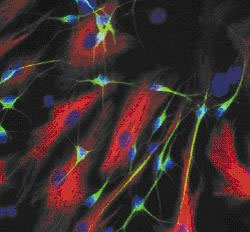Forgetting how to learn
Interview with
When the brain learns it makes new cells called oligodendrocytes. It's their job to wrap around and support nerve fibres. If this process is blocked then learning can't take place as Bill Richardson explained to Chris Smith...
to wrap around and support nerve fibres. If this process is blocked then learning can't take place as Bill Richardson explained to Chris Smith...
Bill - What many neuroscientists have been solving is, how does the brain work, how do we learn and remember new things - new ways of moving, new practical skills? Something must change in your head when you learn something new, but no one has the faintest idea of what that is. Previously, it's been thought that learning was really a neuron thing. Neurons are the cells in your brain that communicate with one another by electrical signals. They send signals down long threads like wires called axons. But we recently found that another type of cell in the brain called oligodendrocytes. Its role is to insulate the wires or the axons of the neurons. They wrap themselves around in a kind of like rolling up a sleeping bag around a snooker cue. Now, we've discovered that these cells continue to be formed throughout adult life in mice. There is evidence also from MRI (magnetic resonance imaging) in humans that white matter which is part of the brain where these axons are all wound up. Those continue to grow throughout human life. guessing that that might be something to do with oligodendrocytes. We decided to test the idea directly that new oligodendrocytes are required for learning complex skills in mice. So, we first of all setup a test of learning ability in mice and mice loved to run on wheels and mice will run the equivalent of 5 to 7 km every night. What we did was, we removed rungs in a quasi-random pattern to create a more difficult task.
Chris - These would be the rungs in the wheel. So the mice, instead of just having to repeatedly move their feet forward by a known distance each time, they're having to second guess whether a rung is missing and adapt their stride accordingly.
Bill - That's absolutely correct. They have severe difficulties and when you look at them and move these, you're amazed that they actually persevere. But they do, they persevere and within a week, they can run as fast in those wheels as they could do on a normal uncomplicated wheel.
Chris - And this is by adapting their running technique. They're having to learn to move at a new way to compensate for the missing rungs.
Bill - That's right.
Chris - So, having engineered this pretty tricky motor learning task for these mice, how do you then tell whether these oligodendrocytes are involved?
Bill - Well, the idea is very simple. If you prevent new oligodendrocytes from forming then they should not be able to learn. We devised a genetic trick that allow the mice to develop normally to adulthood and then inject a drug to flick a genetic switch that would delete a gene required for new oligodendrocytes forming without affecting oligodendrocytes formed previously.
Chris - So, if your theory is correct and learning involves these oligodendrocytes making new contacts and so on, if you block the production of new oligodendrocytes in the brain, you should impair learning. Is that what you found?
Bill - That's what we found. The mice were seriously impaired to learn to run its feet on this complex wheel.
Chris - So, these oligodendrocytes that are being impacted by deleting this gene, they're coming from some kind of stem cell in the brain that produces new oligodendrocytes and you stop that happening so you therefore impair future learning but you don't alter established learning, things you know already.
Bill - Exactly. These new oligodendrocytes are formed by precursor cells, kind of like stem cells and these cells are very numerous in our brains. They're about 5% of all of our brain cells and it was initially a mystery as to why we should have so many of these precursor cells in our brains during adulthood. They are there apparently to provide new oligodendrocytes for learning new practical tasks and maybe they're involved in other types of learning like arithmetic learning and that kind of thing.
Chris - So, what do you think the implications of what you found are?
Bill - What we've uncovered is an additional refinement which is nevertheless essential and that provides us with a new target perhaps that would allow us in time to be able to tweak learning, maybe enhance learning or since it's difficult to forget things. Once you've learned to ride a bicycle, you never forget. It's also very difficult to forget bad habits. So, maybe if we could manipulate oligodendrocytes, we could more easily forget bad habits and relearn them in a better way.










Comments
Add a comment